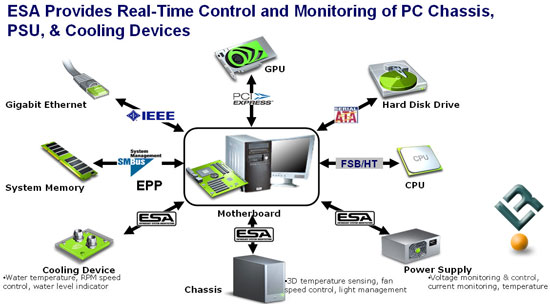NVIDIA Announces Enthusiast System Architecture
Even More Standards – Enthusiast System Architecture

NVIDIA today announced the Enthusiast System Architecture or ESA for short. ESA is the new and exciting initiative to enable PC components to communicate operational information in real-time via internal USB ports to provide enthusiasts with unprecedented software control to manage the conditions within their high-end system. For years enthusiasts have had to download a number of applications to monitor their systems and often these applications showed inaccurate information. The goal behind ESA is to set a specification, so that one piece of software is available to end-users that want to monitor the inner working of their system. It should also be pointed out that ESA is an open industry standard. So, now that we know ESA enables certified PC components (chassis, power supplies, and water cooling systems) to communicate status and control in real-time we can dive deeper into the architecture.

ESA is built around the widely adopted USB specification. Here, ESA defines new USB HID usages for monitoring and controlling ESA devices. This communication is enabled by embedding a microcontroller (containing a USB 2.0-compliant full speed device controller) into the ESA enabled component, and then connecting it through a USB cable to the PC Host. This cabling is typically accomplished internal to the PC chassis using a USB header on the motherboard, but an external USB connection is also supported. Once recognized by the host application, the ESA device can be monitored and controlled via the ESA protocol. A number of companies like CoolIT and Gigabyte already have devices that have monitoring and controlling software, but even they have tweaked their devices and software to support ESA.

The Enthusiast System Architecture will apply to three areas – the chassis, power supply and CPU cooling devices. It will of course monitor the temperature on all of these devices, but that is not all.

Comments are closed.